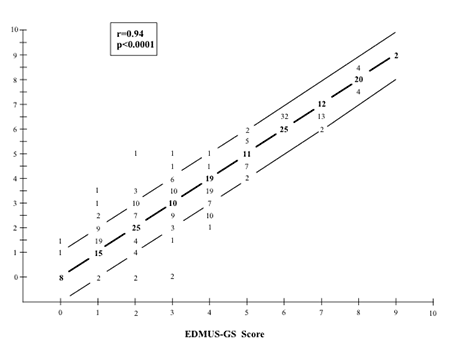Multicentre collaborative studies
coordinated by the EDMUS Coordinating Center
The EDMUS system facilitates the collaboration of neurologists to recruit patients in sufficient number ("critical mass") to answer questions which hitherto have remained unsolved.
Thus, a number of multicentre collaborative studies have been performed using the EDMUS system and coordinated by the EDMUS Coordinating Center. They will be described below.
For current studies, see the "Current Studies" pages.
The EVALUED study (Evaluation of the EDMUS system)
The EVALUED study has validated the EDMUS Grading Scale of disability (EGS/DSS).
The Kurtzke Expanded Disability Status Scale (EDSS) remains the "gold standard" for grading clinical impairment and disability in MS. However, it is far too complex and time-consuming for non-MS specialists and even more so for epidemiological purposes. This is why the EDMUS Steering Committee decided to design the EDMUS-Grading Scale (EGS), a simplified version of the original DSS which would allow similar grading of the patients but could be administered quickly and assessed for its essential points directly through interviewing the patient.
The EVALUED (Evaluation of the EDMUS system) study was a European collaborative multicenter enterprise, involving six European centers under the leadership of Dr. Maria Pia Amato (Florence, Italy). One of the objectives of the project was to assess the inter-examiner reliability of the EDSS and the EGS as well as their correlation.
The close correlation and linear association (r=0.94, p < 0.0001) between the EGS and EDSS scales demonstrated the construct validity of the EGS.
Publication:
Amato MP, Grimaud J, Achiti I, Bartolozzi ML, Adeleine P, Hartung H-P, Kappos L, Thompson A, Trojano M, Vukusic S, Confavreux C for the Evaluation of the EDMUS system (EVALUED) Study Group: European validation of a standardized clinical description of multiple sclerosis. J. Neurol. 2004; 251: 1472-1480.
(Biomed BMH1-CT93-1529, CIPD-CT94-0227 and BMH4-CT96-0064 contracts)

Relationship between the EGS and EDSS scores for the 180 patients
(all examiners, all centers)
The highlighted numbers on the diagonal lines illustrate the frequency of perfect agreement between the scores.